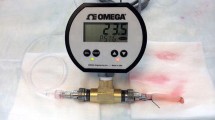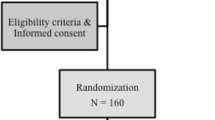Abstract
Introduction
Our objective was to compare the in vitro efficacy of electrothermal bipolar [EB] vessel sealing and ultrasonic harmonic scalpel [HS] versus mechanical interruption, with conventional ties or surgical clips (SC), in sealing saphenous vein (SV) collaterals, during its eventual preparation for bypass surgery.
Methods
Experimental in vitro study on 30 segments of SV. Each fragment included two collaterals at least 2 mm in diameter. One of them was sealed by ligation with 3/0 silk ties (control) and the other one with EB (n = 10), HS (n = 10) or medium-6 mm SC (n = 10). After incorporation in a closed circuit with pulsatile flow, the pressure was progressively increased until causing rupture. Collateral diameter, burst pressure, leak point, and histological study were recorded.
Results
Burst pressure was higher for SC (1320.20 ± 373.847 mmHg) as compared with EB (942.2 ± 344.9 mmHg, p = 0.065), and especially with HS (637.00 ± 320.61 mmHg, p = 0.0001). No statistically significant difference between EB and HS was found, and bursting always happened at supraphysiological pressures. The leak point for HS was always detected in the sealing zone (10/10), while for EB and SC, it occurred in the sealing zone only in 6/10(60%) and 4/10(40%), respectively (p = 0.015).
Conclusions
Energy delivery devices showed similar efficacy and safety in sealing of SV side branches. Although bursting pressure was lower than with tie ligature or SC, non-inferiority efficacy was shown at the range of physiological pressures in both, EB and HS. Due to their speed and easy handling, they may be useful in the preparation of the venous graft during revascularization surgery. However, remaining questions about healing process, potential spread of tissue damage and sealing durability, will require further analysis.




Similar content being viewed by others
References
Rajbabu K, Barber NJ, Choi W et al (2007) To knot or not to knot? Sutureless haemostasis compared to the surgeon’s knot. Ann R Coll Surg Engl 89(4):359–362
Lacin T, Batirel HF, Ozer K et al (2007) Safety of a thermal vessel sealer on main pulmonary vessels. Eur J Cardio-Thorac Surg 31(3):482–485
Toishi M, Yoshida K, Agatsuma H et al (2014) Usefulness of vessel-sealing devices for ≤ 7 mm diameter vessels: a randomized controlled trial for human thoracoscopic lobectomy in primary lung cancer. Interact Cardiovasc Thorac Surg 19(3):448–455
Clements RH, Palepu R (2007) In vivo comparison of the coagulation capability of SonoSurg and Harmonic Ace on 4 mm and 5 mm arteries. Surg Endosc 21(12):2203–2206
Hutchens TC, Giglio NC, Cilip CM et al (2020) Novel optical linear beam shaping designs for use in laparoscopic laser sealing of vascular tissues. Ann Int Conf IEEE Eng Med Biol Soc 2020:5049–5052
Tsunezuka Y, Waseda R, Yachi T (2010) Electrothermal bipolar vessel sealing device LigaSureV for pulmonary artery ligation–burst pressure and clinical experiences in complete video-assisted thoracoscopic major lung resection for lung cancer. Interact Cardiovasc Thorac Surg 11(3):229–233
Katsuno G, Nagakari K, Fukunaga M (2010) Comparison of two different energy-based vascular sealing systems for the hemostasis of various types of arteries: a porcine model-evaluation of LigaSure ForceTriad. J Laparoendosc Adv Surg Tech Part A 20(9):747–751
Elhao M, Abdallah K, Serag I et al (2009) Efficacy of using electrosurgical bipolar vessel sealing during vaginal hysterectomy in patients with different degrees of operative difficulty: a randomised controlled trial. Eur J Obstet Gynecol Reprod Biol 147(1):86–90
Lesser TG, Wolfram F, Boltze C (2013) Sealing of pulmonary arteries with LigaSure: in vivo and ex vivo examinations. J Thorac Cardiovasc Surg 145(6):1525–1528
Martin ST, Heeney A, Pierce C et al (2011) Use of an electrothermal bipolar sealing device in ligation of major mesenteric vessels during laparoscopic colorectal resection. Techn Coloproctol 15(3):285–289
Falcón-Espínola M, Requejo-García L, Plana-Andani E et al (2019) In vitro model to assess energy devices for the sealing of saphenous vein collaterals in revascularization surgery. Angiologia 71(1):2–10
Narloch JA, Brandstater ME (1995) Influence of breathing technique on arterial blood pressure during heavy weight lifting. Arch Phys Med Rehabil 76(5):457–462
Wallwiener CW, Junginger SH, Zubke W et al (2014) Bipolar vessel sealing: instrument contamination and wear have little effect on seal quality and success in a porcine in vitro model. Langenbeck’s Arch Surg 399(7):863–871
Lamberton GR, Hsi RS, Jin DH et al (2008) Prospective comparison of four laparoscopic vessel ligation devices. J Endourol 22(10):2307–2312
Leonardo C, Guaglianone S, De Carli P et al (2005) Laparoscopic nephrectomy using Ligasure system: preliminary experience. J Endourol 19(8):976–978
Ding Z, Wable M, Rane A (2005) Use of Ligasure bipolar diathermy system in vaginal hysterectomy. J Obstet Gynaecol J Inst Obstet Gynaecol 25(1):49–51
Demirturk F, Aytan H, Caliskan AC (2007) Comparison of the use of electrothermal bipolar vessel sealer with harmonic scalpel in total laparoscopic hysterectomy. J Obstet Gynaecol Res 33(3):341–345
Luo Y, Li X, Dong J et al (2017) A comparison of surgical outcomes and complications between hemostatic devices for thyroid surgery: a network meta-analysis. Eur Arch Oto-Rhino-Laryngol Offic J Eur Fed Oto-Rhino-Laryngol Soc 274(3):1269–1278
Richter S, Kollmar O, Schilling MK et al (2006) Efficacy and quality of vessel sealing: comparison of a reusable with a disposable device and effects of clamp surface geometry and structure. Surg Endosc 20(6):890–894
Giusto G, Gandini M (2020) Ex vivo comparison of sliding knot ligatures vs haemostatic clips for equine small intestinal mesenteric vessel occlusion. BMC Vet Res 16(1):290
Landman J, Kerbl K, Rehman J et al (2003) Evaluation of a vessel sealing system, bipolar electrosurgery, harmonic scalpel, titanium clips, endoscopic gastrointestinal anastomosis vascular staples and sutures for arterial and venous ligation in a porcine model. J Urol 169(2):697–700
Hruby GW, Marruffo FC, Durak E et al (2007) Evaluation of surgical energy devices for vessel sealing and peripheral energy spread in a porcine model. J Urol 178(6):2689–2693
Harold KL, Pollinger H, Matthews BD et al (2003) Comparison of ultrasonic energy, bipolar thermal energy, and vascular clips for the hemostasis of small-, medium-, and large-sized arteries. Surg Endosc 17(8):1228–1230
Phillips CK, Hruby GW, Durak E et al (2008) Tissue response to surgical energy devices. Urology 71(4):744–748
Kim FJ, Chammas MF Jr, Gewehr E et al (2008) Temperature safety profile of laparoscopic devices: harmonic ACE (ACE), ligasure V (LV), and plasma trisector (PT). Surg Endosc 22(6):1464–1469
Carpino PA, Khabbaz KR, Bojar RM et al (2000) Clinical benefits of endoscopic vein harvesting in patients with risk factors for saphenectomy wound infections undergoing coronary artery bypass grafting. J Thorac Cardiovasc Surg 119(1):69–75
Nwaejike N, Glizevskaja J, Nair J (2020) Radial artery harvesting for total arterial revascularization multimedia manual of cardiothoracic surgery. Multimed Man Cardiothorac Surg. https://doi.org/10.1510/mmcts.2020.042
Vecherskii II, Zatolokin VV, Petlin KA et al (2017) A new method of endoscopic harvesting of the great saphenous vein in an open system. Angiologiia i sosudistaia khirurgiia Angiol Vasc Surg. 23(2):131–136
Van Linden A, Hecker F, Lehmann-Grube J et al (2020) Randomized trial of 2 endoscopic radial artery harvesting devices-immunofluorescence assessment. Annal Thorac Surg. 110(3):897–902
Kronick M, Liem TK, Jung E et al (2019) Experienced operators achieve superior patency and wound complication rates with endoscopic great saphenous vein harvest compared with open harvest in lower extremity bypasses. J Vasc Surg 70(5):1534–1542
Khan SZ, Rivero M, McCraith B et al (2016) Endoscopic vein harvest does not negatively affect patency of great saphenous vein lower extremity bypass. J Vasc Surg 63(6):1546–1554
Jauhari YA, Hughes CO, Black SA et al (2014) Endoscopic vein harvesting in lower extremity arterial bypass: a systematic review. Eur J Vasc Endovasc Surg 47(6):621–639
Wartman SM, Woo K, Herscu G et al (2013) Endoscopic vein harvest for infrainguinal arterial bypass. J Vasc Surg 57(6):1489–1494
Santo VJ, Dargon PT, Azarbal AF et al (2014) Open versus endoscopic great saphenous vein harvest for lower extremity revascularization of critical limb ischemia. J Vasc Surg 59(2):427–434
Hayashi I, Kashima I, Yoshikawa E (2020) Use of the no-touch saphenous vein harvesting technique via small incisions. Innovations (Phila) 15(1):81–84
Ishizawa A, Hamasaki A, Uchida T et al (2019) Novel harvesting technique of no-touch saphenous vein graft using THUNDERBEAT. Gen Thorac Cardiovasc Surg 67(7):650–652
Burton HE, Williams RL, Espino DM (2017) Effects of freezing, fixation and dehydration on surface roughness properties of porcine left anterior descending coronary arteries. Micron 101:78–86
Cooper IS, Samra K, Wisniewska K (1971) Effects of freezing on major arteries. Stroke 2:471–482
O’Leary SA, Doyle BJ, McGloughlin TM (2014) The impact of long term freezing on the mechanical properties of porcine aortic tissue. J Mech Behav Biomed Mater 37:165–173
Kramer EA, Cezo JD, Fankell DP et al (2016) Strength and persistence of energy-based vessel seals rely on tissue water and glycosaminoglycan content. Ann Biomed Eng 44(11):3421–3431
Diamantis T, Kontos M, Arvelakis A et al (2006) Comparison of monopolar electrocoagulation, bipolar electrocoagulation, ultracision, and ligasure. Surg Today 36:908–913
Gardeweg S, Bockstahler B, Dupre G (2019) Effect of multiple use and sterilization on sealing performance of bipolar vessel sealing devices. PLoS ONE 14(8):e0221488
Acknowledgements
PI20/01171 funded by Instituto de Salud Carlos III (ISCIII) and co-funded by the European Union.
Funding
The following study has obtained a public funding PI20/01171 by Instituto de Salud Carlos III (ISCIII) and co-funded by the European Union.
Author information
Authors and Affiliations
Contributions
MM designed the study. MF performed the experiments. IS-N and MM supervised the analysis. MM, MF, IS-N, EP, PM, LR and AC contributed to the writing of the manuscript.
Corresponding author
Ethics declarations
Conflict of interest
The authors declare that we have no conflict of interest.
Ethical approval
While carrying out this study, all the standards established according to the Ethical Requirements of the journal have been complied with.
Informed consent
Informed consent has been obtained from the patients and relatives from whom all the venous fragments used during this study have been collected.
Additional information
Publisher's Note
Springer Nature remains neutral with regard to jurisdictional claims in published maps and institutional affiliations.
Rights and permissions
Springer Nature or its licensor (e.g. a society or other partner) holds exclusive rights to this article under a publishing agreement with the author(s) or other rightsholder(s); author self-archiving of the accepted manuscript version of this article is solely governed by the terms of such publishing agreement and applicable law.
About this article
Cite this article
Miralles, M., Falcón, M., Requejo, L. et al. "In Vitro" Evaluation of Energy-Based Sealing of Graft Side Branches in Bypass Surgery. World J Surg 47, 2888–2896 (2023). https://doi.org/10.1007/s00268-023-07107-0
Accepted:
Published:
Issue Date:
DOI: https://doi.org/10.1007/s00268-023-07107-0




